Dissertation: Work-Life Balance Investigation of Diageo in the UK
VerifiedAdded on 2020/05/03
|84
|16423
|84
Thesis and Dissertation
AI Summary
This dissertation investigates work-life balance at Diageo in the UK, a British multinational FMCG company. It examines the significance of work-life balance for employee satisfaction, productivity, and retention. The study explores the impact of flexible working arrangements, demographic factors (age, gender, parenthood, and marital status), and the specific characteristics of the FMCG sector on employees' perceptions of work-life balance. The research employs a mixed-methods approach, including a literature review, and analysis. The findings provide insights into the challenges and opportunities for Diageo to improve its work-life balance policies and practices, offering recommendations for enhancing employee well-being and organizational performance. The dissertation is structured into five chapters, covering the introduction, literature review, methodology, analysis and findings, and conclusion with recommendations.
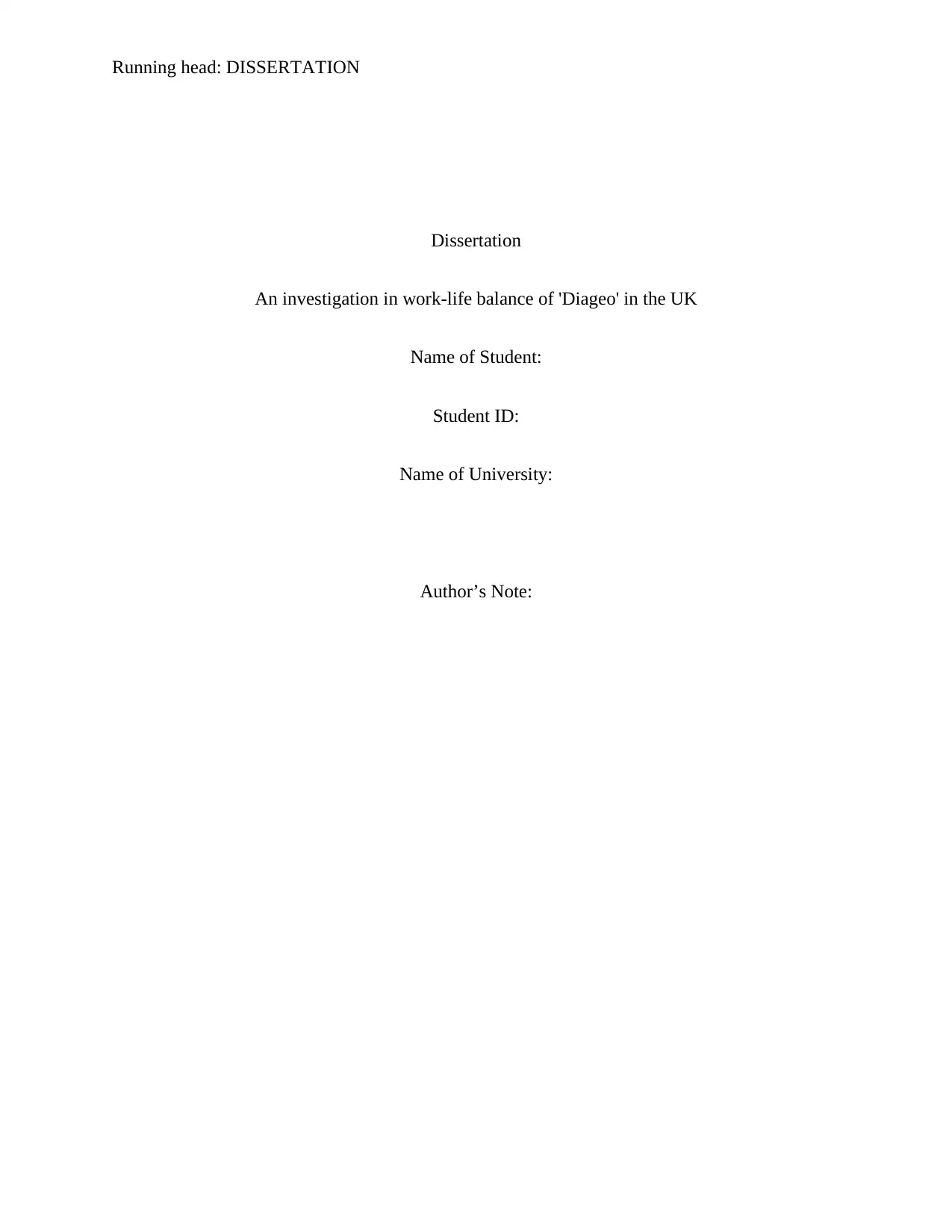
Running head: DISSERTATION
Dissertation
An investigation in work-life balance of 'Diageo' in the UK
Name of Student:
Student ID:
Name of University:
Author’s Note:
Dissertation
An investigation in work-life balance of 'Diageo' in the UK
Name of Student:
Student ID:
Name of University:
Author’s Note:
Paraphrase This Document
Need a fresh take? Get an instant paraphrase of this document with our AI Paraphraser
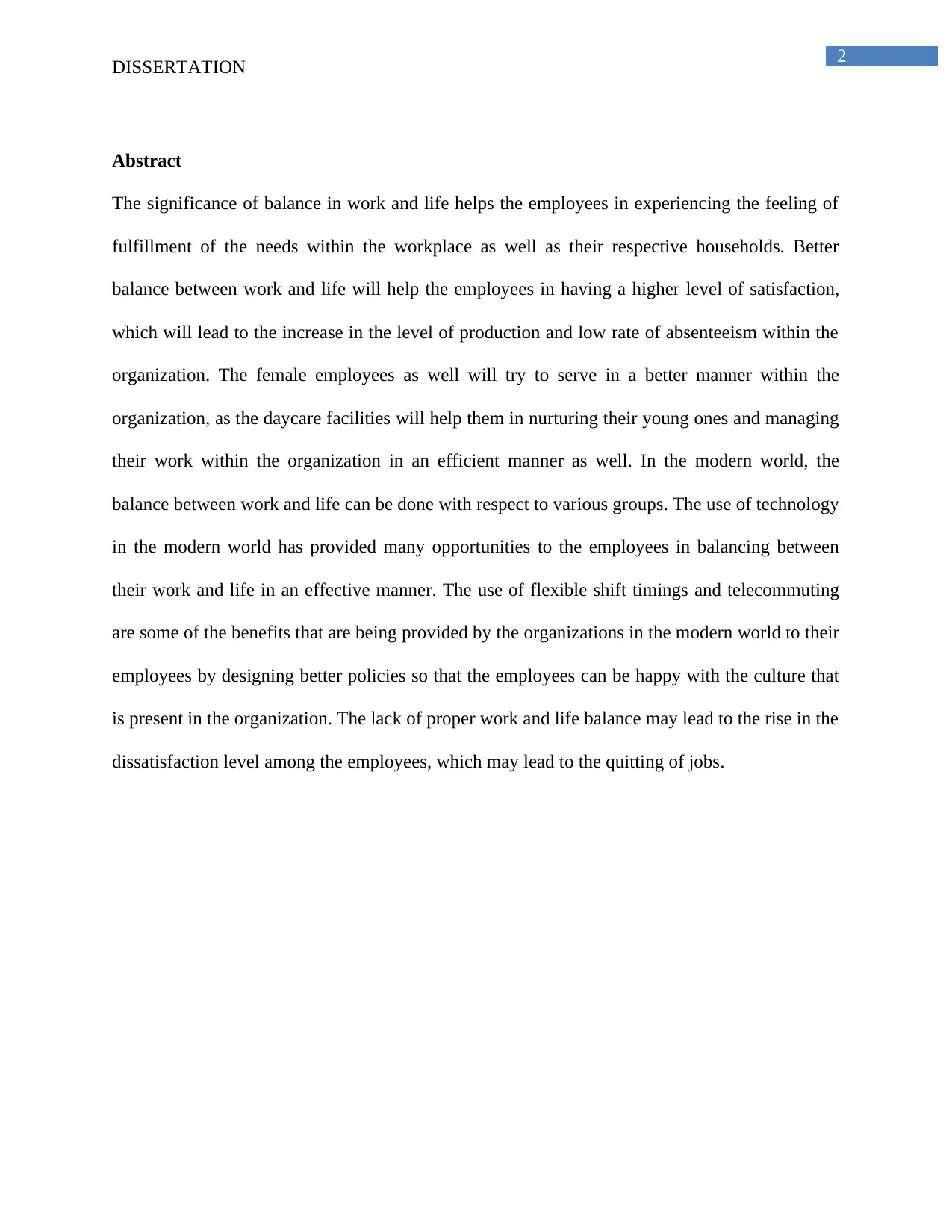
2
DISSERTATION
Abstract
The significance of balance in work and life helps the employees in experiencing the feeling of
fulfillment of the needs within the workplace as well as their respective households. Better
balance between work and life will help the employees in having a higher level of satisfaction,
which will lead to the increase in the level of production and low rate of absenteeism within the
organization. The female employees as well will try to serve in a better manner within the
organization, as the daycare facilities will help them in nurturing their young ones and managing
their work within the organization in an efficient manner as well. In the modern world, the
balance between work and life can be done with respect to various groups. The use of technology
in the modern world has provided many opportunities to the employees in balancing between
their work and life in an effective manner. The use of flexible shift timings and telecommuting
are some of the benefits that are being provided by the organizations in the modern world to their
employees by designing better policies so that the employees can be happy with the culture that
is present in the organization. The lack of proper work and life balance may lead to the rise in the
dissatisfaction level among the employees, which may lead to the quitting of jobs.
DISSERTATION
Abstract
The significance of balance in work and life helps the employees in experiencing the feeling of
fulfillment of the needs within the workplace as well as their respective households. Better
balance between work and life will help the employees in having a higher level of satisfaction,
which will lead to the increase in the level of production and low rate of absenteeism within the
organization. The female employees as well will try to serve in a better manner within the
organization, as the daycare facilities will help them in nurturing their young ones and managing
their work within the organization in an efficient manner as well. In the modern world, the
balance between work and life can be done with respect to various groups. The use of technology
in the modern world has provided many opportunities to the employees in balancing between
their work and life in an effective manner. The use of flexible shift timings and telecommuting
are some of the benefits that are being provided by the organizations in the modern world to their
employees by designing better policies so that the employees can be happy with the culture that
is present in the organization. The lack of proper work and life balance may lead to the rise in the
dissatisfaction level among the employees, which may lead to the quitting of jobs.

3
DISSERTATION
Acknowledgement
I would take the opportunity to thank my professors as without their incessant suppot and
guidance, I would not be able to complete this research work. I also want to show my gratitude
towards almighty for letting me go forward with my topic of research with strength and courage.
Apart from that I would like to show my gratitude towards my family for providing me support
mentally and physically to be able to complete my research. Lastly, I would also like to thank
my friends as they have helped me to get the necessary information to complete my research
work.
Thanks and Regards,
Yours Sincerely,
DISSERTATION
Acknowledgement
I would take the opportunity to thank my professors as without their incessant suppot and
guidance, I would not be able to complete this research work. I also want to show my gratitude
towards almighty for letting me go forward with my topic of research with strength and courage.
Apart from that I would like to show my gratitude towards my family for providing me support
mentally and physically to be able to complete my research. Lastly, I would also like to thank
my friends as they have helped me to get the necessary information to complete my research
work.
Thanks and Regards,
Yours Sincerely,
⊘ This is a preview!⊘
Do you want full access?
Subscribe today to unlock all pages.

Trusted by 1+ million students worldwide
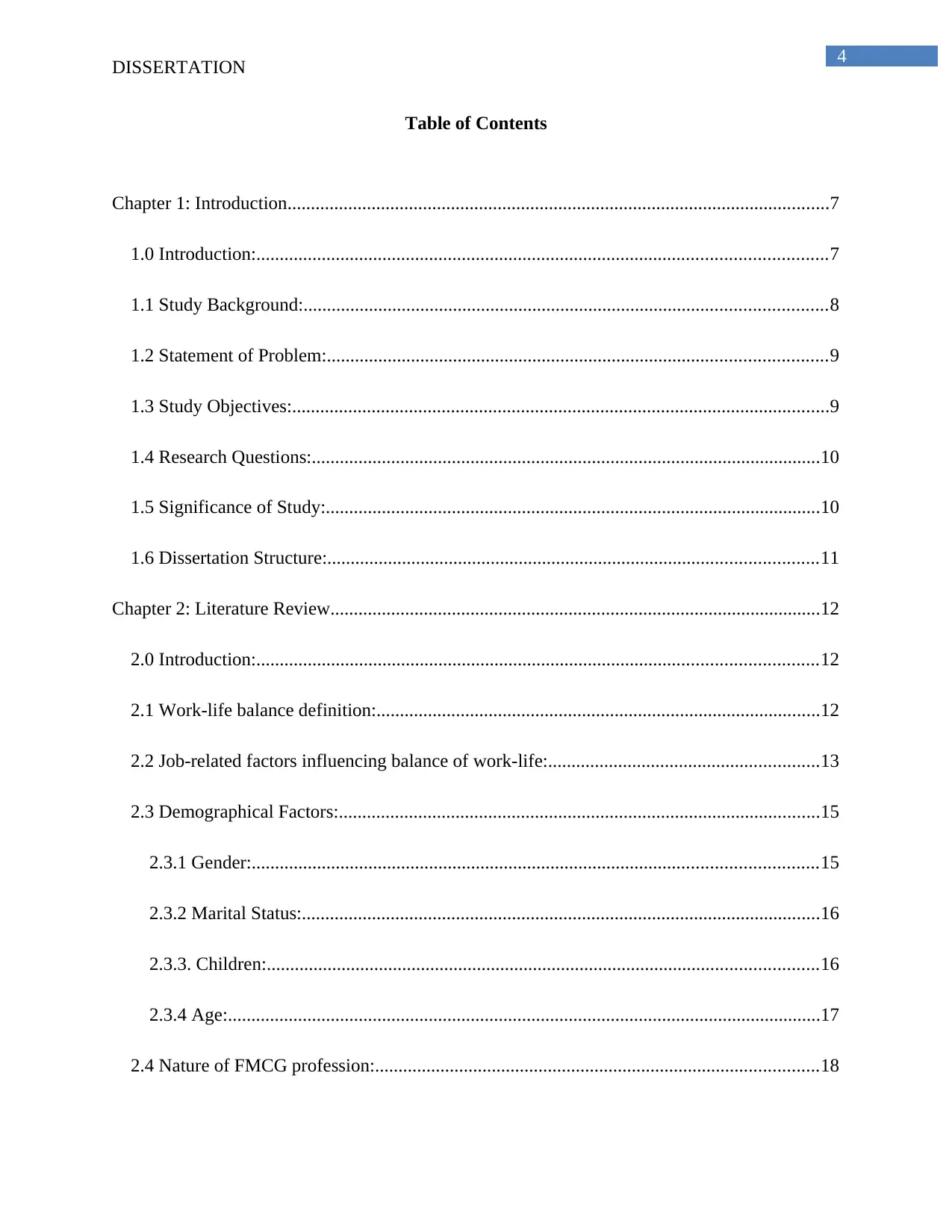
4
DISSERTATION
Table of Contents
Chapter 1: Introduction....................................................................................................................7
1.0 Introduction:..........................................................................................................................7
1.1 Study Background:................................................................................................................8
1.2 Statement of Problem:...........................................................................................................9
1.3 Study Objectives:...................................................................................................................9
1.4 Research Questions:.............................................................................................................10
1.5 Significance of Study:..........................................................................................................10
1.6 Dissertation Structure:.........................................................................................................11
Chapter 2: Literature Review.........................................................................................................12
2.0 Introduction:........................................................................................................................12
2.1 Work-life balance definition:...............................................................................................12
2.2 Job-related factors influencing balance of work-life:..........................................................13
2.3 Demographical Factors:.......................................................................................................15
2.3.1 Gender:.........................................................................................................................15
2.3.2 Marital Status:...............................................................................................................16
2.3.3. Children:......................................................................................................................16
2.3.4 Age:...............................................................................................................................17
2.4 Nature of FMCG profession:...............................................................................................18
DISSERTATION
Table of Contents
Chapter 1: Introduction....................................................................................................................7
1.0 Introduction:..........................................................................................................................7
1.1 Study Background:................................................................................................................8
1.2 Statement of Problem:...........................................................................................................9
1.3 Study Objectives:...................................................................................................................9
1.4 Research Questions:.............................................................................................................10
1.5 Significance of Study:..........................................................................................................10
1.6 Dissertation Structure:.........................................................................................................11
Chapter 2: Literature Review.........................................................................................................12
2.0 Introduction:........................................................................................................................12
2.1 Work-life balance definition:...............................................................................................12
2.2 Job-related factors influencing balance of work-life:..........................................................13
2.3 Demographical Factors:.......................................................................................................15
2.3.1 Gender:.........................................................................................................................15
2.3.2 Marital Status:...............................................................................................................16
2.3.3. Children:......................................................................................................................16
2.3.4 Age:...............................................................................................................................17
2.4 Nature of FMCG profession:...............................................................................................18
Paraphrase This Document
Need a fresh take? Get an instant paraphrase of this document with our AI Paraphraser
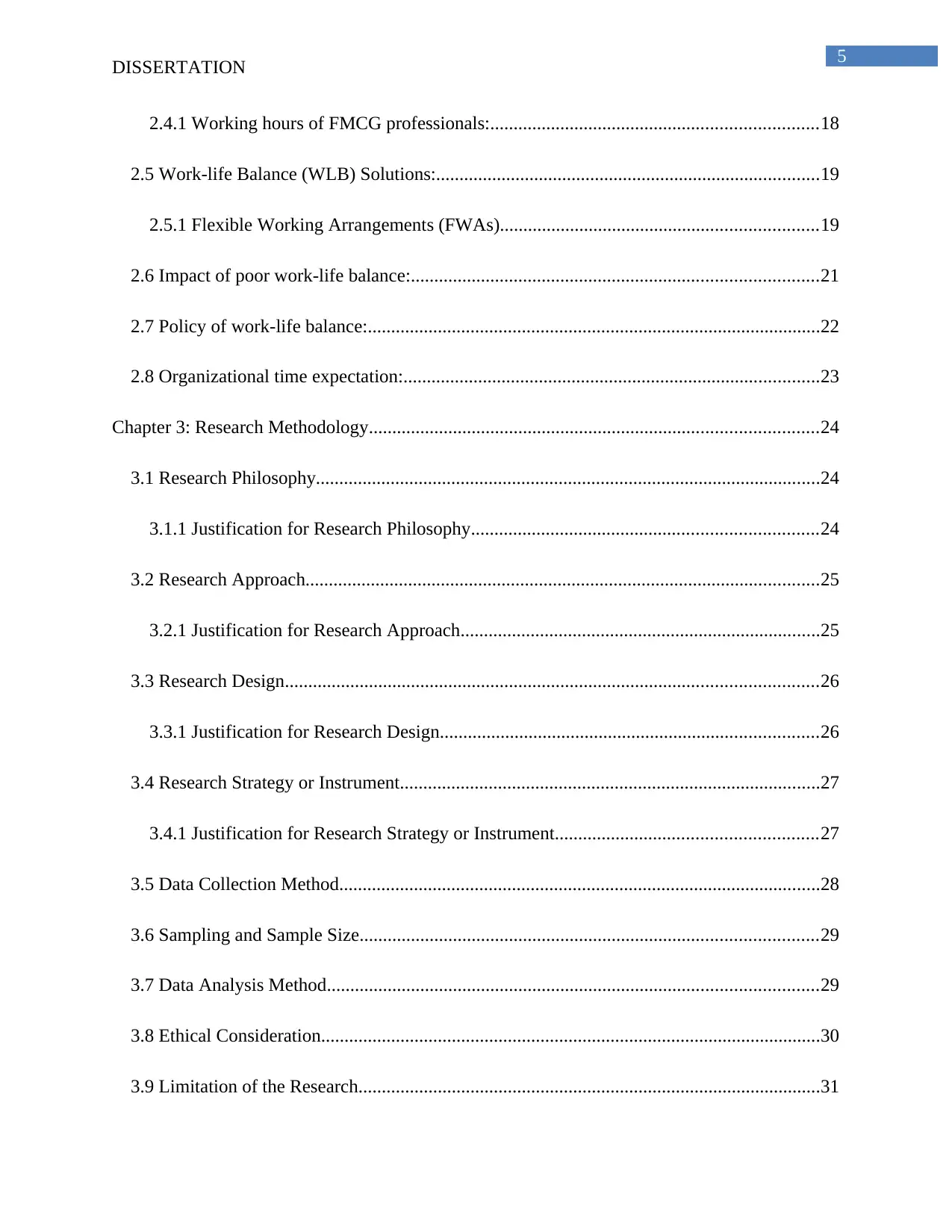
5
DISSERTATION
2.4.1 Working hours of FMCG professionals:......................................................................18
2.5 Work-life Balance (WLB) Solutions:..................................................................................19
2.5.1 Flexible Working Arrangements (FWAs)....................................................................19
2.6 Impact of poor work-life balance:.......................................................................................21
2.7 Policy of work-life balance:.................................................................................................22
2.8 Organizational time expectation:.........................................................................................23
Chapter 3: Research Methodology................................................................................................24
3.1 Research Philosophy............................................................................................................24
3.1.1 Justification for Research Philosophy..........................................................................24
3.2 Research Approach..............................................................................................................25
3.2.1 Justification for Research Approach.............................................................................25
3.3 Research Design..................................................................................................................26
3.3.1 Justification for Research Design.................................................................................26
3.4 Research Strategy or Instrument..........................................................................................27
3.4.1 Justification for Research Strategy or Instrument........................................................27
3.5 Data Collection Method.......................................................................................................28
3.6 Sampling and Sample Size..................................................................................................29
3.7 Data Analysis Method.........................................................................................................29
3.8 Ethical Consideration...........................................................................................................30
3.9 Limitation of the Research...................................................................................................31
DISSERTATION
2.4.1 Working hours of FMCG professionals:......................................................................18
2.5 Work-life Balance (WLB) Solutions:..................................................................................19
2.5.1 Flexible Working Arrangements (FWAs)....................................................................19
2.6 Impact of poor work-life balance:.......................................................................................21
2.7 Policy of work-life balance:.................................................................................................22
2.8 Organizational time expectation:.........................................................................................23
Chapter 3: Research Methodology................................................................................................24
3.1 Research Philosophy............................................................................................................24
3.1.1 Justification for Research Philosophy..........................................................................24
3.2 Research Approach..............................................................................................................25
3.2.1 Justification for Research Approach.............................................................................25
3.3 Research Design..................................................................................................................26
3.3.1 Justification for Research Design.................................................................................26
3.4 Research Strategy or Instrument..........................................................................................27
3.4.1 Justification for Research Strategy or Instrument........................................................27
3.5 Data Collection Method.......................................................................................................28
3.6 Sampling and Sample Size..................................................................................................29
3.7 Data Analysis Method.........................................................................................................29
3.8 Ethical Consideration...........................................................................................................30
3.9 Limitation of the Research...................................................................................................31
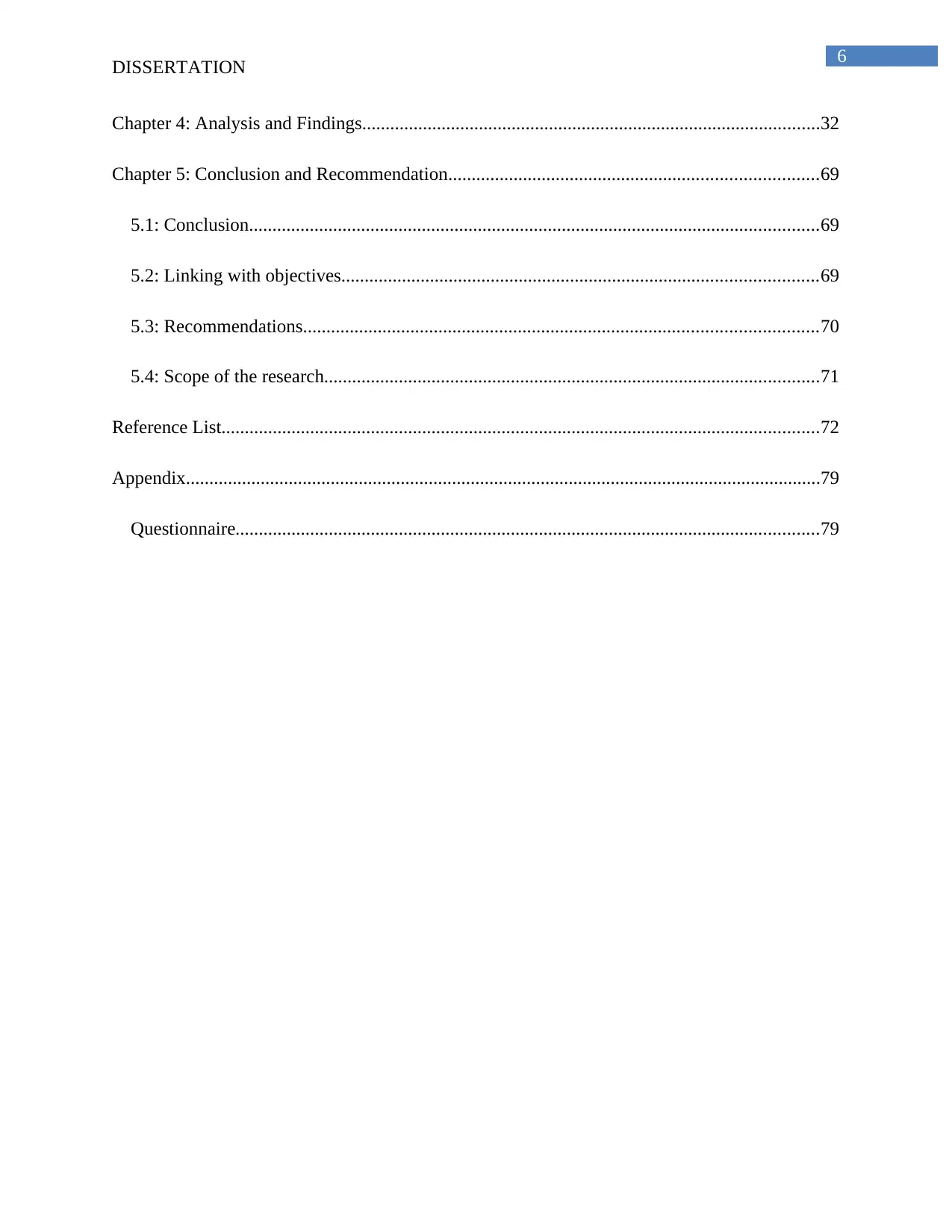
6
DISSERTATION
Chapter 4: Analysis and Findings..................................................................................................32
Chapter 5: Conclusion and Recommendation...............................................................................69
5.1: Conclusion..........................................................................................................................69
5.2: Linking with objectives......................................................................................................69
5.3: Recommendations..............................................................................................................70
5.4: Scope of the research..........................................................................................................71
Reference List................................................................................................................................72
Appendix........................................................................................................................................79
Questionnaire.............................................................................................................................79
DISSERTATION
Chapter 4: Analysis and Findings..................................................................................................32
Chapter 5: Conclusion and Recommendation...............................................................................69
5.1: Conclusion..........................................................................................................................69
5.2: Linking with objectives......................................................................................................69
5.3: Recommendations..............................................................................................................70
5.4: Scope of the research..........................................................................................................71
Reference List................................................................................................................................72
Appendix........................................................................................................................................79
Questionnaire.............................................................................................................................79
⊘ This is a preview!⊘
Do you want full access?
Subscribe today to unlock all pages.

Trusted by 1+ million students worldwide
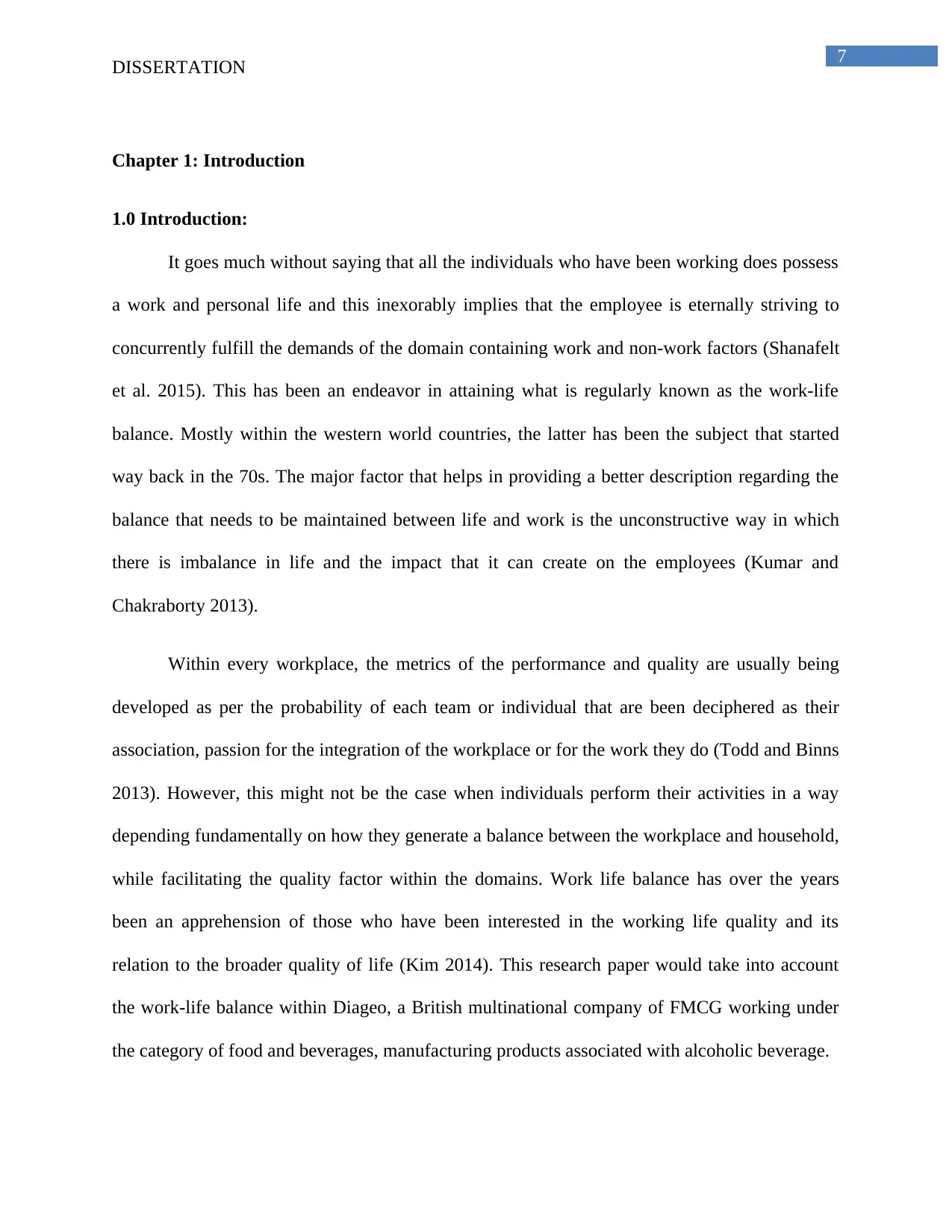
7
DISSERTATION
Chapter 1: Introduction
1.0 Introduction:
It goes much without saying that all the individuals who have been working does possess
a work and personal life and this inexorably implies that the employee is eternally striving to
concurrently fulfill the demands of the domain containing work and non-work factors (Shanafelt
et al. 2015). This has been an endeavor in attaining what is regularly known as the work-life
balance. Mostly within the western world countries, the latter has been the subject that started
way back in the 70s. The major factor that helps in providing a better description regarding the
balance that needs to be maintained between life and work is the unconstructive way in which
there is imbalance in life and the impact that it can create on the employees (Kumar and
Chakraborty 2013).
Within every workplace, the metrics of the performance and quality are usually being
developed as per the probability of each team or individual that are been deciphered as their
association, passion for the integration of the workplace or for the work they do (Todd and Binns
2013). However, this might not be the case when individuals perform their activities in a way
depending fundamentally on how they generate a balance between the workplace and household,
while facilitating the quality factor within the domains. Work life balance has over the years
been an apprehension of those who have been interested in the working life quality and its
relation to the broader quality of life (Kim 2014). This research paper would take into account
the work-life balance within Diageo, a British multinational company of FMCG working under
the category of food and beverages, manufacturing products associated with alcoholic beverage.
DISSERTATION
Chapter 1: Introduction
1.0 Introduction:
It goes much without saying that all the individuals who have been working does possess
a work and personal life and this inexorably implies that the employee is eternally striving to
concurrently fulfill the demands of the domain containing work and non-work factors (Shanafelt
et al. 2015). This has been an endeavor in attaining what is regularly known as the work-life
balance. Mostly within the western world countries, the latter has been the subject that started
way back in the 70s. The major factor that helps in providing a better description regarding the
balance that needs to be maintained between life and work is the unconstructive way in which
there is imbalance in life and the impact that it can create on the employees (Kumar and
Chakraborty 2013).
Within every workplace, the metrics of the performance and quality are usually being
developed as per the probability of each team or individual that are been deciphered as their
association, passion for the integration of the workplace or for the work they do (Todd and Binns
2013). However, this might not be the case when individuals perform their activities in a way
depending fundamentally on how they generate a balance between the workplace and household,
while facilitating the quality factor within the domains. Work life balance has over the years
been an apprehension of those who have been interested in the working life quality and its
relation to the broader quality of life (Kim 2014). This research paper would take into account
the work-life balance within Diageo, a British multinational company of FMCG working under
the category of food and beverages, manufacturing products associated with alcoholic beverage.
Paraphrase This Document
Need a fresh take? Get an instant paraphrase of this document with our AI Paraphraser

8
DISSERTATION
1.1 Study Background:
Purpose has a significant role at Diageo; a global premium drinks company that has been
leading the pack, and their principle of celebrating life, every moment, everywhere is extensive
and full of prospects. They have this notion within themselves that when their people are fulfilled
or their desires are met they deliver enhanced performance (Gatrell et al. 2013). They judge in
making the most out of life, being the best at workplace, at home with the family, with friends, in
and for the community. In line with the principle, employees celebrated International Day of
Families. They maintained the theme focusing on the raising of consciousness of the
accountability towards family and the family policies through the sharing of what exactly family
is to them. It is about the ways Diageo sustains them in attaining a balance of work-life (Yadav
and Dabhade 2014). This research would thus hold immense importance to many other
organizations not only in UK but across the globe in understanding what exactly needs to be
done so that employees are able to deliver their best through maintaining the balance of work-
life. Many organizations have found it hard in implementing policies and schemes for their
employees so that they are able to maintain the work-life balance (Kar and Misra 2013).
Another important concern within the field of work-life balance that has been taken into
consideration by this current research study is the perception of the culture related to work-life
that has been described the authors. Work-life culture that encompasses of various sub-
components takes in the degree of support that is received by the employees from his/her
supervisors has been used mainly in explaining why the policies related to work-life may or may
not be thriving (Deery and Jago 2015). Another major apprehension is the expectation that is
been positioned by the company on the time that is being committed to the latter by the
employees. This expectation of the organizational time has also been an ingredient of the
DISSERTATION
1.1 Study Background:
Purpose has a significant role at Diageo; a global premium drinks company that has been
leading the pack, and their principle of celebrating life, every moment, everywhere is extensive
and full of prospects. They have this notion within themselves that when their people are fulfilled
or their desires are met they deliver enhanced performance (Gatrell et al. 2013). They judge in
making the most out of life, being the best at workplace, at home with the family, with friends, in
and for the community. In line with the principle, employees celebrated International Day of
Families. They maintained the theme focusing on the raising of consciousness of the
accountability towards family and the family policies through the sharing of what exactly family
is to them. It is about the ways Diageo sustains them in attaining a balance of work-life (Yadav
and Dabhade 2014). This research would thus hold immense importance to many other
organizations not only in UK but across the globe in understanding what exactly needs to be
done so that employees are able to deliver their best through maintaining the balance of work-
life. Many organizations have found it hard in implementing policies and schemes for their
employees so that they are able to maintain the work-life balance (Kar and Misra 2013).
Another important concern within the field of work-life balance that has been taken into
consideration by this current research study is the perception of the culture related to work-life
that has been described the authors. Work-life culture that encompasses of various sub-
components takes in the degree of support that is received by the employees from his/her
supervisors has been used mainly in explaining why the policies related to work-life may or may
not be thriving (Deery and Jago 2015). Another major apprehension is the expectation that is
been positioned by the company on the time that is being committed to the latter by the
employees. This expectation of the organizational time has also been an ingredient of the
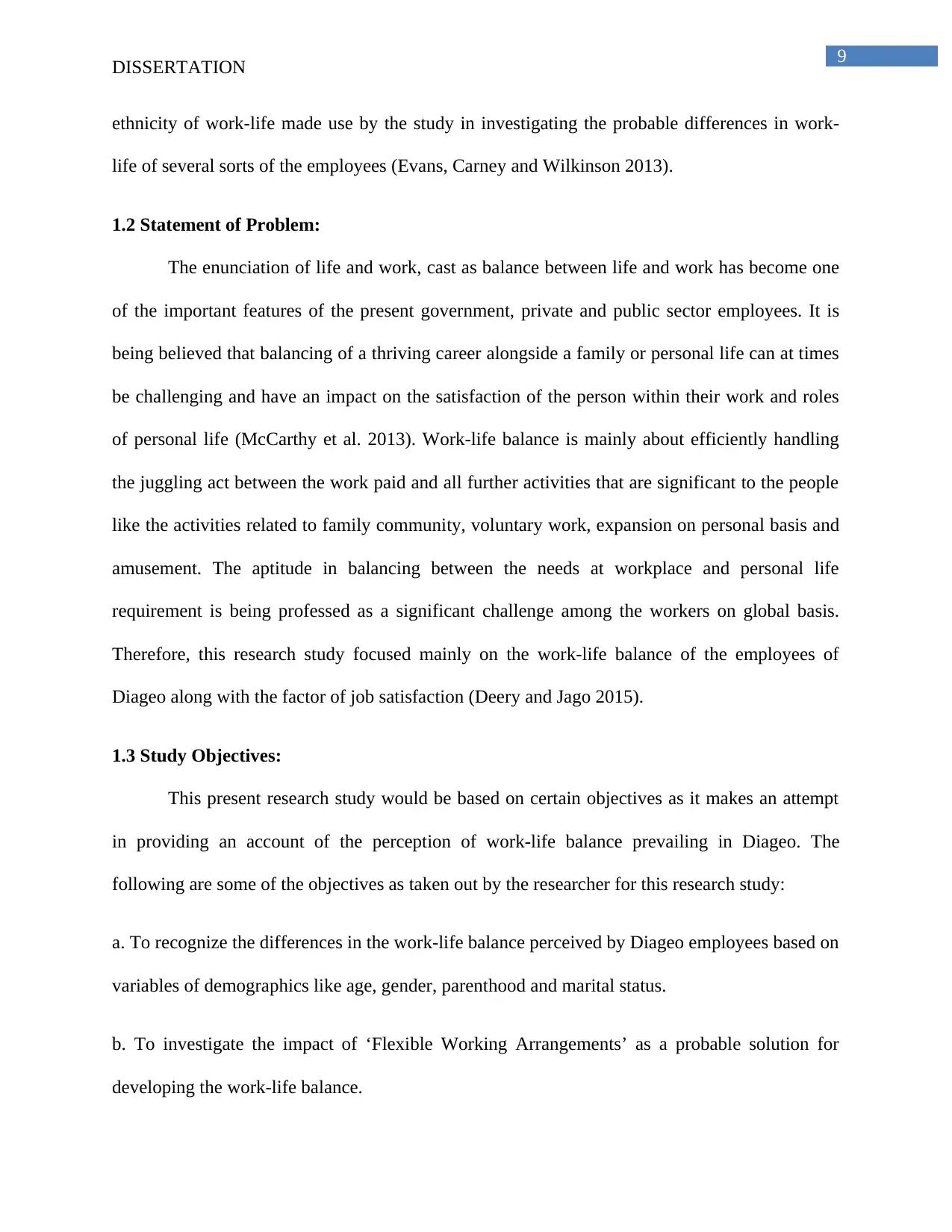
9
DISSERTATION
ethnicity of work-life made use by the study in investigating the probable differences in work-
life of several sorts of the employees (Evans, Carney and Wilkinson 2013).
1.2 Statement of Problem:
The enunciation of life and work, cast as balance between life and work has become one
of the important features of the present government, private and public sector employees. It is
being believed that balancing of a thriving career alongside a family or personal life can at times
be challenging and have an impact on the satisfaction of the person within their work and roles
of personal life (McCarthy et al. 2013). Work-life balance is mainly about efficiently handling
the juggling act between the work paid and all further activities that are significant to the people
like the activities related to family community, voluntary work, expansion on personal basis and
amusement. The aptitude in balancing between the needs at workplace and personal life
requirement is being professed as a significant challenge among the workers on global basis.
Therefore, this research study focused mainly on the work-life balance of the employees of
Diageo along with the factor of job satisfaction (Deery and Jago 2015).
1.3 Study Objectives:
This present research study would be based on certain objectives as it makes an attempt
in providing an account of the perception of work-life balance prevailing in Diageo. The
following are some of the objectives as taken out by the researcher for this research study:
a. To recognize the differences in the work-life balance perceived by Diageo employees based on
variables of demographics like age, gender, parenthood and marital status.
b. To investigate the impact of ‘Flexible Working Arrangements’ as a probable solution for
developing the work-life balance.
DISSERTATION
ethnicity of work-life made use by the study in investigating the probable differences in work-
life of several sorts of the employees (Evans, Carney and Wilkinson 2013).
1.2 Statement of Problem:
The enunciation of life and work, cast as balance between life and work has become one
of the important features of the present government, private and public sector employees. It is
being believed that balancing of a thriving career alongside a family or personal life can at times
be challenging and have an impact on the satisfaction of the person within their work and roles
of personal life (McCarthy et al. 2013). Work-life balance is mainly about efficiently handling
the juggling act between the work paid and all further activities that are significant to the people
like the activities related to family community, voluntary work, expansion on personal basis and
amusement. The aptitude in balancing between the needs at workplace and personal life
requirement is being professed as a significant challenge among the workers on global basis.
Therefore, this research study focused mainly on the work-life balance of the employees of
Diageo along with the factor of job satisfaction (Deery and Jago 2015).
1.3 Study Objectives:
This present research study would be based on certain objectives as it makes an attempt
in providing an account of the perception of work-life balance prevailing in Diageo. The
following are some of the objectives as taken out by the researcher for this research study:
a. To recognize the differences in the work-life balance perceived by Diageo employees based on
variables of demographics like age, gender, parenthood and marital status.
b. To investigate the impact of ‘Flexible Working Arrangements’ as a probable solution for
developing the work-life balance.
⊘ This is a preview!⊘
Do you want full access?
Subscribe today to unlock all pages.

Trusted by 1+ million students worldwide

10
DISSERTATION
c. To offer a varied viewpoint looking at the facets of the FMCG job in trying to describe
probable differences in the work-life balance perceived.
1.4 Research Questions:
This research would be based on several questions on the basis of which the researcher
would be going along with the further studies of the same. The following questions of the
research guided this quantitative research study:
a. How demographic factors identify the dissimilarities within work-life balance perceives by
Diageo employees?
b. How ‘Flexible Work Arrangements’ might help in developing a proper equilibrium for work-
life balance.
c. What relationship exists between the job satisfaction and work-life balance among the
employees at Diageo?
1.5 Significance of Study:
Employees who generally lead a life that is imbalanced in nature, where either the
personal life takes more than preferred preponderance on the professional life or vice-versa leads
to negative outcomes with the FMCG sector being no exception. It has been seen when the work-
life balance is not attained, employees generally faces issues related to stress at physical level
like exhaustion and at the mental extent like depression and irritability. This is not without the
significance for the employer since it might interpret within issues like productivity loss from
augmented absenteeism, decreased obligation in organizations that might even lead to an
amplified purpose to relinquish by the employees. Consequently, while the present study would
be adding to the assortment of the academic materials existing over the database stemming out
DISSERTATION
c. To offer a varied viewpoint looking at the facets of the FMCG job in trying to describe
probable differences in the work-life balance perceived.
1.4 Research Questions:
This research would be based on several questions on the basis of which the researcher
would be going along with the further studies of the same. The following questions of the
research guided this quantitative research study:
a. How demographic factors identify the dissimilarities within work-life balance perceives by
Diageo employees?
b. How ‘Flexible Work Arrangements’ might help in developing a proper equilibrium for work-
life balance.
c. What relationship exists between the job satisfaction and work-life balance among the
employees at Diageo?
1.5 Significance of Study:
Employees who generally lead a life that is imbalanced in nature, where either the
personal life takes more than preferred preponderance on the professional life or vice-versa leads
to negative outcomes with the FMCG sector being no exception. It has been seen when the work-
life balance is not attained, employees generally faces issues related to stress at physical level
like exhaustion and at the mental extent like depression and irritability. This is not without the
significance for the employer since it might interpret within issues like productivity loss from
augmented absenteeism, decreased obligation in organizations that might even lead to an
amplified purpose to relinquish by the employees. Consequently, while the present study would
be adding to the assortment of the academic materials existing over the database stemming out
Paraphrase This Document
Need a fresh take? Get an instant paraphrase of this document with our AI Paraphraser

11
DISSERTATION
from the advanced countries, it might serve as a mechanism to guide the domestic professionals
in a better manner with respect to human resource and those positioned at management levels
and gaining an understanding of several aspects of the issues associated to life and work.
1.6 Dissertation Structure:
This current dissertation would be consisting of five main sections. Chapter 1 would be
dealing with the introductory part along with the background of the overall dissertation. Chapter
2 offers a detailed discussion of the literature existing related to the subject along with the
theoretical structure for questions of research and probable answers. Chapter 3 is about stating
the methodology that would be used for this particular research. Chapter 4 would take in details
about the analysis performed along with the findings of subsequent nature. Chapter 5, the last
one deals with added discussion generally based on the findings and conclusions that can be
made on the research. Certain recommendations would also be provided within the conclusion
part for Diageo to improve more on its work-life balance part which is what the researcher has
set out to do in this research study.
DISSERTATION
from the advanced countries, it might serve as a mechanism to guide the domestic professionals
in a better manner with respect to human resource and those positioned at management levels
and gaining an understanding of several aspects of the issues associated to life and work.
1.6 Dissertation Structure:
This current dissertation would be consisting of five main sections. Chapter 1 would be
dealing with the introductory part along with the background of the overall dissertation. Chapter
2 offers a detailed discussion of the literature existing related to the subject along with the
theoretical structure for questions of research and probable answers. Chapter 3 is about stating
the methodology that would be used for this particular research. Chapter 4 would take in details
about the analysis performed along with the findings of subsequent nature. Chapter 5, the last
one deals with added discussion generally based on the findings and conclusions that can be
made on the research. Certain recommendations would also be provided within the conclusion
part for Diageo to improve more on its work-life balance part which is what the researcher has
set out to do in this research study.

12
DISSERTATION
Chapter 2: Literature Review
2.0 Introduction:
The primary aim of this chapter is to provide a better review of literature that will provide
understandings and insights regarding the concept of balance that needs to be maintained
between life and work. The focus would be on the factors that are thought to have a particular
impact on the balance between life and work. The literature would be focusing on the working
parents along with their needs, the review would commence with the broader characterization of
the work-life balance underpinning the current research pursued by a prologue of work/non-work
conflict. The impact of the poor balance within work-life is being discussed before concluding
on the present status of the policy of work-life balance.
2.1 Work-life balance definition:
The work and life balance has received much consideration with regards to academics in
the present years, which has resulted in the various definitions related to the topic (Rama Devi
and Nagini 2014). Work-life balance generally refers to having adequate time along with energy
in handling both commitments related to work and non-work. Attaining a satisfactory balance
within work-life factor has positive impact on the presentation of the job. It can also be referred
as the satisfaction factor so that with the help of divergence of roles can help in a proper
functioning between work and home (Direnzo, Greenhaus and Weer 2015).
In the late 90s the perception of conflict between non-work and work had cropped up.
The non-work component includes all the areas of the life of a person outside that of work, like
the activities related to learning, community work, and fitness while taking in family along with
care responsibilities (Grawitch et al. 2013). When individuals fail in attaining a satisfactory
DISSERTATION
Chapter 2: Literature Review
2.0 Introduction:
The primary aim of this chapter is to provide a better review of literature that will provide
understandings and insights regarding the concept of balance that needs to be maintained
between life and work. The focus would be on the factors that are thought to have a particular
impact on the balance between life and work. The literature would be focusing on the working
parents along with their needs, the review would commence with the broader characterization of
the work-life balance underpinning the current research pursued by a prologue of work/non-work
conflict. The impact of the poor balance within work-life is being discussed before concluding
on the present status of the policy of work-life balance.
2.1 Work-life balance definition:
The work and life balance has received much consideration with regards to academics in
the present years, which has resulted in the various definitions related to the topic (Rama Devi
and Nagini 2014). Work-life balance generally refers to having adequate time along with energy
in handling both commitments related to work and non-work. Attaining a satisfactory balance
within work-life factor has positive impact on the presentation of the job. It can also be referred
as the satisfaction factor so that with the help of divergence of roles can help in a proper
functioning between work and home (Direnzo, Greenhaus and Weer 2015).
In the late 90s the perception of conflict between non-work and work had cropped up.
The non-work component includes all the areas of the life of a person outside that of work, like
the activities related to learning, community work, and fitness while taking in family along with
care responsibilities (Grawitch et al. 2013). When individuals fail in attaining a satisfactory
⊘ This is a preview!⊘
Do you want full access?
Subscribe today to unlock all pages.

Trusted by 1+ million students worldwide
1 out of 84
Related Documents
Your All-in-One AI-Powered Toolkit for Academic Success.
+13062052269
info@desklib.com
Available 24*7 on WhatsApp / Email
![[object Object]](/_next/static/media/star-bottom.7253800d.svg)
Unlock your academic potential
Copyright © 2020–2025 A2Z Services. All Rights Reserved. Developed and managed by ZUCOL.





